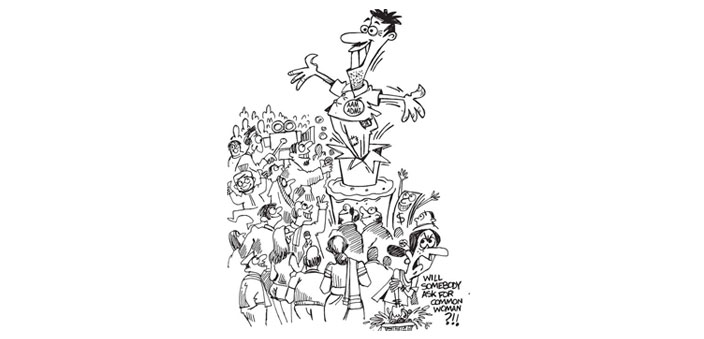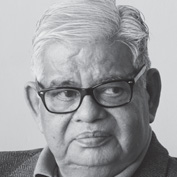The one appellation that gained currency in the last two years is The Common Man. As more and more countries emerged out of the shackles of colonialism and opted for democratic regimes in independent republics, they became democracies for namesake and transformed into gerontocracies, or democracies in appearance but dynastic in its form. The most popular, and apt definition of Democracy, given by Abraham Lincoln, seems non-applicable to current day democracies. The demos have receded in the background and the new ruling class seems to be reaping the benefits. No doubt, they needed support in the form of popular vote to remain in power, but they managed to earn such support both with muscle and money power. The Common Man becomes the object of adulation only when elections knock the door. His power is his vote, and many are happy with its sale.
The status quo challenged by the Common Man
Independent India began its democratic journey with the euphoria caused by the success of the freedom struggle. Of course, this struggle was led by committed leadership that came from the middle classes – as they alone had the luxury to think and organise the agitation, while the poor and the downtrodden remain worried about the next meal for the family. An obliged electorate handed over power to them upon gaining independence, and remained contented with the exercise of the vote once in five years. Since they were not the claimants to positions of power, they were least bothered about the people who occupied the throne. But even in such a scenario, the electorate tested the power of the ballot in 1967 elections,when the ruling party was virtually swept out. Recent Assembly elections in Delhi mark a repeat performance. The Common Man is now in a mood to challenge the status quo to cleanse the system and bring about innovation to enhance transparency and block channels of corruption.
In the early years, the largely illiterate populace did not cherish the hope to take the reins and felt satisfied with the little crumbs showered as charity to the downtrodden. The winners earned votes from those who could hardly understand the manifestos presented in high flown language. The Common Man was satisfied with the purchase money and the Desi Tharra. The intelligentsia remained largely unconcerned with the “dirt” of politics and most often refrained from exercising their right to vote. The winners boasted of the vast mandate from the electorate. The Congress led Alliance – UPA—talks of people’s mandate in its favour, while the fact is that it had to seek support from other parties to form a post-election alliance. Contrary to the spirit of the Constitution, the Party gave the Prime Minister for two consecutive terms, the man who never fought the election for the lower house. He owes his chair to the family-run Congress. The small ruling elite – be it in power or out of it – has made every citizen of India a Common Man. Of course, the prosperous among them have access to the seat of power from the back door. It is the large Middle Class and the burgeoning ranks of the poor who constitute the Common Man.
The emergence of a new leadership
Of late, the Common Man has acquired skills to articulate his sorrows and grievances. A new leadership within it is emerging which is now entering the power field, not to opt for the prevailing political culture but to promote an alternative culture. This is facilitated by growing literacy, expanding urbanisation, and information revolution, which has created highways of communication and widened the circles of empathy.
Meanwhile, India’s political culture has also changed. From one-party dominant system, we have moved to the politics of alliance and the rise of regional parties. While these new parties have remained confined mostly to the regions where they originated – despite their claims to national coverage – they have thrown up some competitors to the ruling dynasty, misleadingly called Nehru-Gandhi dynasty. The Gandhi in this nomenclature, it may be noted, has nothing to do with the selfless Mahatma who lived the life of a Common Man!
While these political outfits have considerable following in their respective regions, at the national level their presence is registered by the quality of noise they could create. Using the same model as those of the first ruling party of the country, these regional satraps have also amassed good deal of wealth and can no longer be classed as Common Men; their claim to serve the Man-in-the Street is no more than a lip service. In the last two years a new politics has emerged that has given a new diction and a different grammar to Indian politics.
Rather than talking of the poverty of the masses, it has taken cudgels against the establishment by highlighting misgovernance and rampant corruption. Corruption in high places involving billions of rupees on the one hand, and on the other, corruption in bureaucracy at lower levels which disallows movement of files without the grease of bribe money, have acted as multipliers of dissent and grudge against the politics of the day. This has agonised India and thrown up leadership of selfless persons like Anna Hazare and Arvind Kejriwal. Both served together to make corruption the key issue of concern to the Indian polity hurting the Common Man – the Man-in-the Street – irrespective of what economic class he/she belongs. The tirade is against the prevailing political milieu and the corrupt officialdom and top political leadership.
AAP – the distinguishing feature of 2013
The emergence of AAP –Aam Aadmi Party (Party of the Common Man) – is one distinguishing feature of the year 2013. Born with lot of apprehensions, and even disagreement between Anna and Kejriwal, the Party did a successful pilot project in the Union Territory of Delhi by challenging the establishment. The ruling party brushed aside AAP’s claims and dismissed it completely, but the Common Man retorted by granting it as many as 28 out of 70 seats in the State Assembly, making it second to BJP, and bringing down the ruling Congress to bare eight seats. While none of the three groups got a clear majority, AAP made history by accepting the offer of the Lt. Governor to form the Government. It is not surprising that it is receiving accolades from all parties – openly or obliquely. The entire political spectrum has been taken by surprise. Although born in Delhi, AAP is assuming all-India proportions. In Punjab alone, its primary membership has quadrupled. In Haryana, it is all set for both the Assembly and Lok Sabha seats; even the Chief Ministerial candidate is unofficially announced. The Party is also ready to put up a candidate against Rahul Gandhi in Amethi, U.P. The electorate of that Constituency may spring a surprise!
AAP has begun garnering support from different states in the country. Mumbai’s Meera Sanyal, Chairperson of the Royal Bank of Scotland has joined AAP. Alka Lamba of the Congress Party and Kamal Farooqui of Samajvadi Party have also taken steps to join AAP. Shiv Sena regards AAP’s stunning victory in Delhi as Chamatkar –a charismatic happening. Singer Remo Fernandes from Goa has already joined AAP. And many more are likely to join. AAP is no longer the movement confined to Delhi. It has already announced its intention to put up candidates for about 300 Lok Sabha seats. Haryana is its next target. The Common Man is surging!
The recent happenings in the political arena have changed the very perception of the Common Man. He is not the beggar waiting to receive the doles or relief; he has begun to demand what is his due. Governments hitherto devised the schemes of charity for the poor. It is now well-known that envelopes of charity had holes to filter out the money for the middlemen and for the parties with the result that, as publicly admitted by Rajiv Gandhi, a meagre 10 to 12 percent reached its destination. Schemes like MGNREGA functioned as torn envelopes.
The Common Man knows. He shuns charity as he enters the arena of power. Politics of the coming years will be different.


